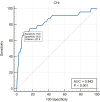Reference values for reticulocyte haemoglobin equivalent in healthy Chinese children under 5 years and its associations with various blood parameters
- PMID: 39209439
- PMCID: PMC11367340
- DOI: 10.1136/bmjpo-2024-002736
Reference values for reticulocyte haemoglobin equivalent in healthy Chinese children under 5 years and its associations with various blood parameters
Abstract
Background: Reticulocyte haemoglobin equivalent (RET-He) is a useful tool for evaluating recent iron usage irrespective of inflammatory status. This study aims to establish a reference for RET-He among Hong Kong healthy children under the age of 5 years and to investigate the association between RET-He and various blood parameters.
Methods: A total of 946 children aged 2-48 months from July 2019 to December 2022 were recruited in this cross-sectional study. The RET-He and other haematological parameters were measured by the haematology analyser from Sysmex XN-9100/XN-1500. The ferritin test was performed with the electrochemiluminescence immunoassay. Interval 2.5th percentile to 97.5th percentile represented the normal RET-He ranges. Linear multiple regression analysis was performed to examine the relation between RET-He and various blood parameters. Receiver-operating characteristic curve analysis revealed the sensitivity and specificity of RET-He in identifying iron deficiency.
Results: The RET-He in the study population was approximately normally distributed. The age-specific lower limit of RET-He ranges from 25.81 pg (25-36 months) to 27.15 pg (13-24 months). RET-He was found to be lower in the age group 2-6 months (mean=29.47 pg) and 7-12 months (mean=29.41 pg). Changes in RET-He and haemoglobin in relation to age were observed in both sexes (both p<0.001). RET-He was influenced by age, some red blood cell parameters and reticulocyte concentrations (all p<0.05). A cut-off value of RET-He ≤27.8 pg was determined for identifying iron deficiency.
Conclusions: RET-He levels varied with age, with a relatively lower level in infants than in other age groups. The value below the age-specific lower limit of the reference range of RET-He can be used as a limit for preliminary iron-deficiency screening.
Keywords: Child Health; Infant.
© Author(s) (or their employer(s)) 2024. Re-use permitted under CC BY-NC. No commercial re-use. See rights and permissions. Published by BMJ.
Conflict of interest statement
Competing interests: none.
Figures
References
-
- Zhao J, Chen S, Wan R, et al. Status of malnutrition and its influencing factors in children under 5 years old in Guangnan District of Yunnan Province in 2009 - 2010. Wei Sheng Yan Jiu. 2013;42:67–71. - PubMed
MeSH terms
Substances
LinkOut - more resources
Full Text Sources


